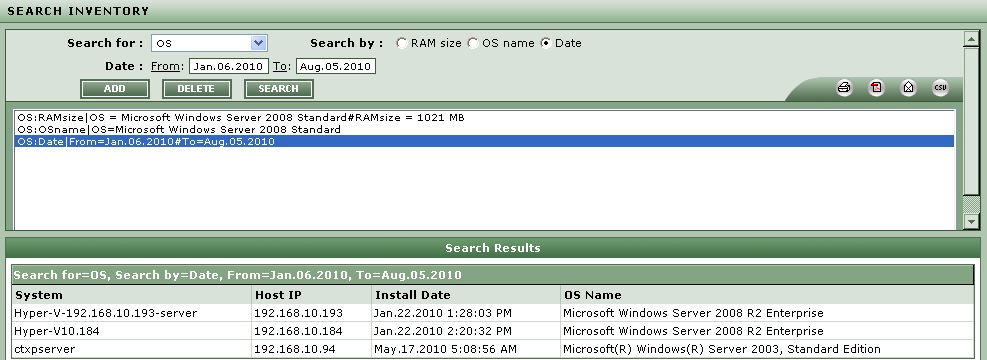Operating System
- To locate systems that are running specific operating systems, select OS from the Search for list. Such a list of systems will be useful not only during a routine stock taking exercise, but will also come in handy while planning a software/service pack deployment, RAM upgrade, etc.
- To invoke this list, do the following after selecting OS from the Search for list:
- Indicate the basis for your search by picking one of the following options from the Search by section:
-
RAM size: Select this option as depicted in Figure 1, if you want to know which systems running a specific OS have been configured with a particular RAM size. Upon selecting this option, pick an OS from the OS list, and then, choose one of the following options from the RAM size list.
- Equals: Select this option and then pick a RAM size from the list box adjacent to it to invoke the list of systems running the chosen OS that have been configured with the chosen RAM size (see Figure 1).
- Less than: Select this option and then pick a RAM size from the list box adjacent to it to view the list of systems with RAM size lesser than the chosen RAM size.
- Less than or equal to: If you want to know which systems have been configured with RAM that is lesser than or equal to a chosen RAM size, select this option from the RAM size list and then pick a RAM size from the list box adjacent to it.
- Greater than: Select this option and then pick a RAM size from the list box adjacent to it to view the list of systems with RAM size greater than the chosen RAM size.
-
Greater than or equal to: If you want to know which systems have been configured with RAM that is greater than or equal to a chosen RAM size, select this option from the RAM size list and then pick a RAM size from the list box adjacent to it.

Figure 1 : Inventory search of a operating system through RAM size wise
-
OS name: Select this option from Search by as depicted in Figure 2, if you want to view the details of systems that are running a particular OS. Once this option is chosen, pick an operating system to search for from the OS list. To view the details of systems regardless of OS, pick the All option from the OS list.

Figure 2 : Inventory search of a operating system through OS name wise
-
Date: Select this option from Search by as depicted in Figure 3, if you want to view the details of systems that were installed during a specific time period. Once this option is chosen, specify the start date and end date of this time period using the From and To calendar controls against Date.

Figure 3 : Inventory search of a operating system through date wise
- Every time you pick a Search by option and build a search query, you can add that search query to the list box below by clicking on the ADD button in this page. This way, you can add multiple queries to the list. To remove a query from the list, select the query and click the DELETE button. To execute a single query, select it from the list box and click the SEARCH button. This page will then display the details of systems that fulfill the search criteria included in the chosen query. If multiple queries are to be executed simultaneously, select all the queries of interest to you from the list box, and click the SEARCH button. Each query will be executed independently, and the results of each query will be displayed in separate sections in this page. To execute all the queries in the list box at one shot, just click on the SEARCH button.
